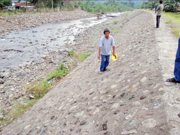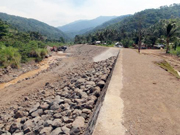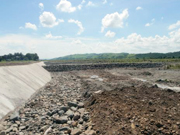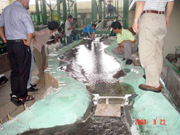Project News
2009-11-10
Progress of Pilot Project
In our project, the Pilot Project have been implemented on 3 sites, namely (1) Kinanliman River, (2) Digmala River and (3) Santa Fe River for the purpose of progress in flood control and sabo technologies in the Philippines.
 Water rose to the level he is pointing
Water rose to the level he is pointing
 Completion of Construction Work in Kinanliman River(2nd Stage)
Completion of Construction Work in Kinanliman River(2nd Stage)
(1) On the Kinanliman River in Real City, Quezon Province, embankment and revetment were planned to construct. Following the completion of the first stage construction of the 200-meter-long embankment and revetment last year, the second stage construction of additional 70 meters was finished.
In the second stage construction, we used the technology of underpining, in which we dig the lower part of existing revetment and build the deeper additional foundation. With this technology, we succeeded in reducing cost and wastes of the construction. In order to protect the revetment foundation, we used rocks found a lot in the riverbed as riprap and aim to minimize the environmental influence caused by transportation of construction materials.
Typhoon Ondoy (Typhoon No. 16) landed around Infanta City next to Real City, where the Kinanliman River runs. In the Kinanliman River also, water rose as high as the residential area's ground level along the river. However the water level was much lower than the tops of the banks; therefore the area was not flooded, which showed the embankment constructed in the pilot project prevented flooding. This was a great pleasure to us all, participated in the project.
 Completion of Construction Work in Digmala River(1st Stage)
Completion of Construction Work in Digmala River(1st Stage)
(2) As the Digmala River in Bongabon City, Nueva Ecija Province, flows in a fan shape, changing river flows eroded the banks and flooded residential areas and agricultural land. To prevent flooding, we completed embankment and spurdike were planned. In the first stage project work, we completed the 250-meter-long embankment and three spurdikes. In the spurdikes structures we adopted the technology of piling rocks of a more than 40 cm diameter found a lot in the riverbank.
By utilizing the materials available on the site, we reduced the construction cost and aim to set a good example of designing and construction economically and technically feasible in the Philippines.
As the second stage construction work planned to order in the fiscal 2009, we are drafting detailed designs of embanking the lower part of the river and rebuilding irrigation intakes built in the banks into draining pipes. As for draining pipes, we are designing the structure, in which operating gates is not necessary, considering its actual management.
Typhoons Ondoy (No16) and Pepen (No17) caused no large freshet in the river, or flooding or damage to the river facilities.
 Hydraulic Model Experiment
Hydraulic Model Experiment
(3) In the Santa Fe River in Santa Fe Municipality, Nueva Vizcaya Province, we are drafting detailed design of sabo embankment of about 50 m length and 9.5 m height so as to prevent river bed rise, caused by outflow of soil, flooding and land slide. We are planning to use ‘soil cement’ mixture of soil and cement, as embankment material, which has never used in the Philippines. ‘Soil cement’ is an environmentally friendly technology in that by utilizing soil available on the site as material, we can expect to reduce disposal cost of soil left and emission of CO2 caused by soil transportation. The Philippines has had many landslides and mud flood disasters, in which a lot of lives were lost.
However the nation does not have a technology of designing and building sabo embankment, one of the most effective countermeasures, on its own; therefore foreign aids built sabo only in limited areas. As ‘sabo embankment by using soil cement’ is expected to greatly cut construction cost, compared with sabo embankment by using conventional cement, this technology is considered to be the most suitable for the Philippines, which needs to build many sabos with the limited budget. We hope this technology will be adopted in many rivers. Along with drafting designs, we are continuing to verify and modify the design standard.
We are carrying out the hydraulic model experiment of the Santa Fe River, in order to verify the effect and influence. In detail we are inspecting sediment accumulation brought about by sabo embankment construction in the upper part and situation changes of effect on scoring in the lower part.
- About JICA
- News & Features
- Countries & Regions
- Our Work
- Thematic Issues
- Types of Assistance
- Partnerships with Other Development Partners
- Climate Change / Environmental and Social Considerations
- Evaluations
- Compliance and Anti-corruption
- Science and Technology Cooperation on Global Issues
- Research
- JICA Development Studies Program / JICA Chair
- Support for the Acceptance of Foreign HRs / Multicultural and Inclusive Community
- Publications
- Investor Relations
